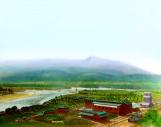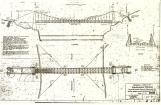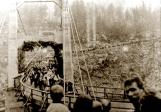16
Work was six days per week while the Sabbath (Sunday) was respected and was usually incorporated into large sobranies where Doukhobors could gather with Doukhobors from other villages in praise of the Almighty. It was no doubt that these sobranies also served a social function for people from one village to meet with those from another, and it was also during these sobranies that many a courtship had started between a young man and woman from different villages.18
In all of the Doukhobors' enterprises, perhaps none were as impressive as the jam factory and the resultant enterprises of such. The K.C. Preservative Works began in 1910 in Brilliant, at the confluence of the Columbia and Kootenay Rivers, and continued in operation past the demise of the CCUB, and until December 1943. This would become the main office for all the CCUB enterprises from here to Saskatchewan.21
Lush Brilliant, BC OrchardsLate 1910s
Brilliant, BC, Canada
 Credits:
Credits:From the Autochrome Exhibit, Doukhobor Village Museum, Castlegar, BC
22
The jam factory (as with most other Doukhobor enterprises) flourished during this period. Preservatives were used not only by the Doukhobors themselves but markets opened up from English-speaking non-Doukhobors. The Ooteshenie side's bountiful harvest was originally transported by a ferry operated by the Doukhobors, across the Kootenay River for processing at the KC Jam Factory (as it became known).Also, produce from Ooteshenie was becoming popular to all groups and getting this produce to market was getting to be a continual problem with the ferry, mostly because of fluctuating river levels. The jam factory also offered an opportunity to other non-Doukhobor independent growers to sell their produce which the Doukhobors would even go pick. The growers themselves described these relations with the Doukhobors as satisfactory and fair.
24
Verigin could easily see that a new transportation method was needed to get produce to the factory and as well, a better system of linking the villages on the Ooteshenie side to the Brilliant side. He approached the government for funding and they simply replied, "No". Verigin was a man with a vision and knowing nothing about building bridges, he instructed that a buoy-like pyramid structure be constructed and anchored mid-river where he felt the bridge should be built, and left anchored there until flood waters came in spring. When the flood waters receded, and nothing was left of the structure, Verigin knew that he would have to resort to a professional firm to design this bridge.26
Though planning and preparation began as early as 1911, construction using plans drawn by a Vancouver, BC engineering firm commenced on April of 1913. The Brilliant Suspension Bridge was completed 7 months later in October, at a cost to the Doukhobors of $60,000. It was interesting to some elders who recalled prior to their passing, how an English-speaking engineer could have communicated instructions to the Russian-speaking workers. But over 40 Doukhobor men from the nearby villages worked on this bridge for 11 hour days, six days per week, for seven months without pay - as was the communal way. Though actually on private property at the time, the bridge continued to serve the people between the communities for nearly another five decades at no charge to them. An interesting landmark which many elders still recall was the sign on the bridge which read:"Strictly Prohibited: smoking and trespassing with fire arms over this bridge".27
Suspended In Time1998
Brilliant, BC, Canada
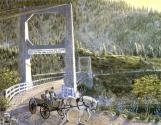 Credits:
Credits:Painting by Michael M. Voykin of Shoreacres, BC, 1974
28
Aside from the sporadic but yet infrequent uprisings of the Sons of Freedom, the Doukhobors it seemed were once again in their 'Golden Years'. All operations were flourishing, the Valley of Consolation seemed to become the Valley of Prosperity and most were inclined to be satisfied with their peaceful way of communal life. The enterprises in Saskatchewan were thriving too with their own grain elevator, flour mill, brick factory, and other operations.Generally, there were a few that couldn't abide by the communal system that left on their own accord to become independent land owners or workers in BC, and there were those that were literally banished for not following the 'rules' of the community. But on the most part, the Doukhobors were at a relatively rare, peaceful and prosperous time in their lives.
29
The Verigin Community store1911
Verigin, Saskatchewan, Canada
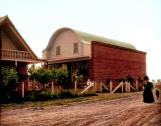 Credits:
Credits:Self portrait of Russian photographer Alexandra Korcini
